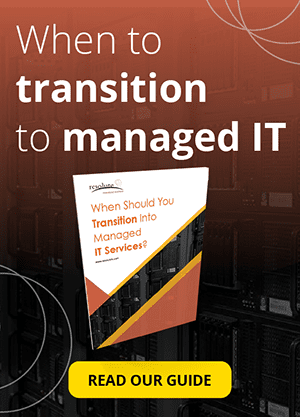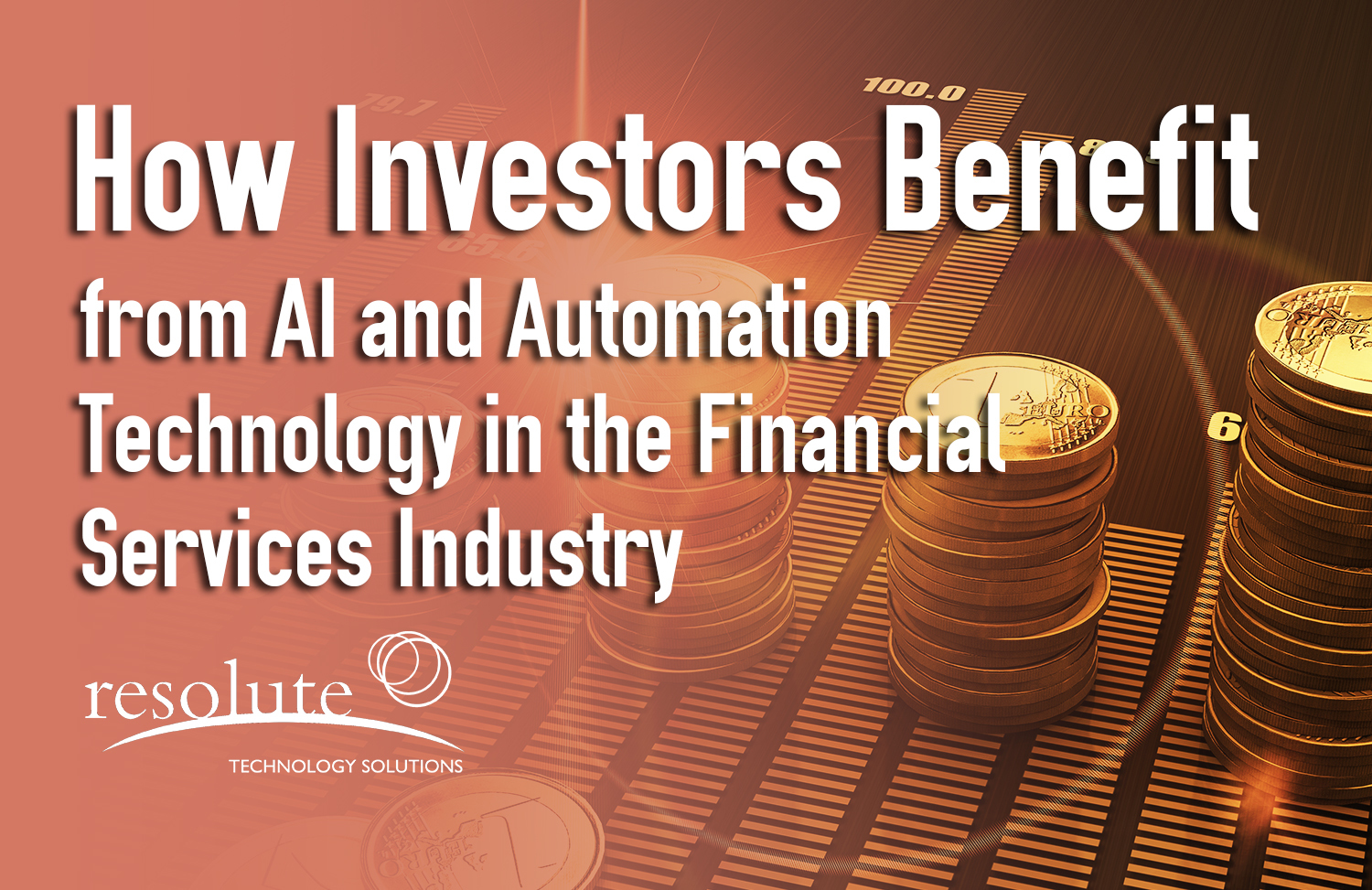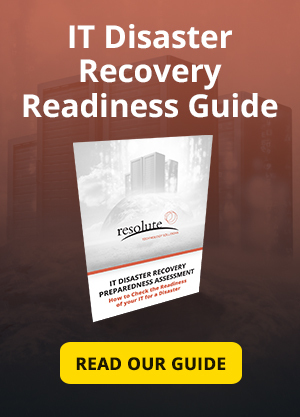In part-one of this series, Resolute Technology Solutions’ President Rod De Vos provided insight into how process automation and artificial intelligence (AI) are helping wealth management firms compete efficiently in the post-recession financial services market. New and emerging technology in the financial services industry has become key in lowering overhead costs and, in turn, offer client investors competitive fees.
Interviewer: So today we’re joined by Colton and Rod from Resolute Technology Solutions. We’re going to talk a little bit about some of the financial industry technology trends to watch out for in 2018. I want to hand it over to Colton and Rod for just a quick introduction of your roles with the company and your knowledge in this space.
Rod De Vos: Hi, it’s Rod De Vos, I’m President of Resolute Technology Solutions. I’ve been in the financial services business technology industry for over 30 years. Always operating from a tech perspective, but have been around from the days of paper-based investing through advisors to the latest trends of today, such as robo-advisors and fully digital solutions.
Colton De Vos: I’m Colton De Vos, I do the marketing work here, design work, and social media. Happy to talk to you.
Interviewer: Thanks for that. So today, as I mentioned at the beginning, we’re going to be looking at overall digital trends in the wealth management and the financial services industry at large. Of course, a lot of that centers around the wealth management digital transformation. With that, of course, you mentioned you work with several industry leaders in that space and I’d like to talk about some of the trends that you’re seeing.
Leveraging Process Automation to Reduce Back-End Costs
Rod De Vos: I’ll start with the first trend: Given the market pressures post-recession, which are driving wealth management firms to have lower margins, firms have focused on digital transformation and process automation. This includes trying to get more efficient with the business functions that they’re performing in order to drive potentially greater efficiencies and reduce costs because their management fees are being pressured to reduce their management fee ratios down, which basically ends up driving less profits for them. So they have to get more efficient and more automated at what they’re doing. They started by essentially automating, i.e. trying to get rid of the paper through online data entry of the five phases of wealth management.
So it starts right from the client onboarding process, such as collecting all the know-your-client information, where it’s all digitally entered today as opposed to filling out paperwork for that. Client portfolio summaries are now available digitally via mobile, websites or voice-activated with full integration with back-end office systems being available to the investor. being available to the investor.
There’s automating the FAQs. So if you had questions that can be answered without actually talking to humans, thus reducing the demand for massive call centers. You can use the digital experience delivered to your customers to generate additional leads for advisors or you can also use chatbots to mine the data into some level of artificial intelligence. This entire process also helps with compliance, meeting regulatory checks as they enter the data.
Need a Strong Grasp of How to Automate Your Back-End Processes?
Reach Out to Resolute Today!
Digital Transformation is Driven by Customer Demand
Interviewer: Now, if I can jump in. You mentioned that there are, of course, ongoing pressures to reduce the administrative costs and the administrative burdens so that there’s additional funding available for the investments themselves. Are there any other pressures that are driving this kind of process automation? Are there pressures from the customer side? Or is it all internal?
Rod De Vos: No, there’s pressure from customers, especially high net-worth individuals under 40 years old, they have a much higher demand for a digital experience. They want more capabilities in their hands to actually use and input their information and to control their user experience in terms of getting their balances, checking their portfolio and even running a small level of reports or analytics against the portfolio.
Colton De Vos: Yeah, so it’s a far stretch from what used to be quarterly or annual reports, whereas now you can see real-time updates right from your device or from your platform.
Rod De Vos: As well as alerts.
Interviewer: That’s really interesting. Now, as you discussed, all financial institutions are working towards this direction. How deep would you say the adoption rate is for this digital transformation? Of course, you mentioned that there’s now increased competition from robo-advisors and other wealth management firms that have automated processes. How deep are the adoption rates? Does it vary based on the sizes of firms operating in Canada?
Rod De Vos: It’s more related to wealth management firms, but actually, it’s occurring by segments. To some degree, it could be a retired individual seeing their portfolio via the web or on their phone, just to check the ‘nest-egg’ that they already have and how they’re doing with it.
While saving [money], you’re actually more in the managing of your account or the accumulation phase of your life. For example, a hit to the stock market today against your portfolio will tell you how much longer you have to work, or how much quicker you can retire. So, there’s much more activity in terms of monitoring those things on an ongoing basis than there was prior.
So it’s because the next generation of wealth management clients are demanding it, it’s a “me too” for the firms to actually provide it.
Interviewer: That’s really interesting. Now, of course, as you were saying, there are a number of different processes that are being automated – from client onboarding to FAQ sections – that can get rid of call centers and things like that. What exactly is involved in achieving, let’s say, full process automation, and could you speak to whether some are easier to automate than others, or if there’s a logical progression to the automating of processes at your institution?
Rod De Vos: Well, typically, in a back-end piece, it means basically integrating a number of systems together so that it’s seamless. Formerly, if they weren’t automated you’d manually be taking either paper or data from one system onto the next system if the suite didn’t have a level of integration connecting all the systems together and passing it along and repeating it.
Obviously, if you’re an investor benefitting from a digital experience and entering the information you’re not going to be repeating from system to system. It needs to be seamless like you never switched systems in the process. A lot of that integration that has to happen, it has to happen by the financial services firm in order to prepare for an end-to-end digital experience.
Interviewer: So essentially what we’re looking at here is far more involved than just purchasing a chatbot software and placing it as a plug-in on the front-end of your website, but in fact, there’s a deep level of integration involved across technology – both in terms of legacy and perhaps newer technology they may have been implemented sooner – and some of the people involved at those steps that you’re trying to automate, and the processes that connect the two?
Rod De Vos: Correct.
Our consultants have over 25 years of experience equipping the financial services industry with flexible technology solutions.
Request a free consultation to see how we can help you.
Using AI to Engage Customers
Interviewer: Perfect. Of course, let’s say we take a forward-looking approach here. If you’re a financial institution that has automated many of these processes, if not all of them, what’s the next step then in the list of trends that you’ve seen if you’ve automated all of these processes? Is there a next logical progression?
Rod De Vos: Yes, so you’ve automated your processes, the next step is essentially using a form of artificial intelligence to have the client answer the questions, like profiling. The investor is entering their information in terms of two or three different savings goals that they need by entering their profile information. They may very well be filling out a questionnaire and their answers to the questions have to use some level of artificial intelligence in order to be smart enough to say the answers make sense and I – as the firm – guided the customer through it. What I’m doing by that level of automation and intelligence is I’m augmenting the human advisor.
Interviewer: At least for that function.
Rod De Vos: At least for that function. I may not replace the advisor entirely, in which case I may be having a hybrid-type service. But, knowing my own needs and savings goals as the end-investor, that comes from me internally. So, in which case, I just need the right questions to be asked of me in order to answer them to fill out my profile information.
However, that piece of data needs to be solid because the client information that you enter is used by the regulatory compliance world in order to make sure that your underlying investments down the road are aligned with that particular savings goal that you identify.
So that’s the use of artificial intelligence by tying compliance into it. A really good example of that in the Canadian market is WealthSimple, it’s Canada’s largest robo-advisor.
Culminating Process Automation by Deploying Chatbots
Interviewer: Now can you speak to the robo-advisor that’s right now in place at WealthSimple; is it essentially the culmination of everything in the first trend of process automation?
So they’ve automated many processes from client to onboarding to back office operations to the FAQ and regulatory checks. And now, as a result of having these people, technology, and processes integrated they’ve been able to plug a robo-advisor – an AI essentially – on the front-end on the customer facing end.
Rod De Vos: Yeah, and they do allow for a financial advisor actually tying in at some point in the process. So it’s a bit of a hybrid model. All true technology essentially.
Interviewer: Now that’s very interesting. If the Wealth Simple example is a case of everything being integrated at the process level such that you can enable the AI, how many other wealth management firms across the country would you say are at this level with WealthSimple?
Or is WealthSimple really the leader in that space and really out and ahead on their own?
Rod De Vos: Well I believe they started that way from scratch, whereas the rest of the traditional wealth management firms started much before WealthSimple, so they’re working their way backwards from paper.
Colton De Vos: It’s those legacy systems they have to deal with versus a start-up just being able to go with all new technology.
Interviewer: It’s very interesting that you bring that up. Let’s say if we’re recognizing that process-automation is that first step in the wealth management digital transformation process, what percentage of the Canadian wealth management marketplace has their process automated to the degree that they could start moving into adopting AI?
Rod De Vos: I don’t know the percentage off the top of my head, I know that it’s on everyone’s agenda to be working on it.
In part-two, Rod De Vos examines how wealth management firms are leveraging data to handle many essential tasks while also enhancing the customer service experience.
Resolute Technology Solutions’ IT leadership, professional services, app design and development experience and managed services will equip your financial services firm to seamlessly integrate people, technology and processes into supporting its strategic goals. Schedule a call with us now to learn how we can get you started.
[]








